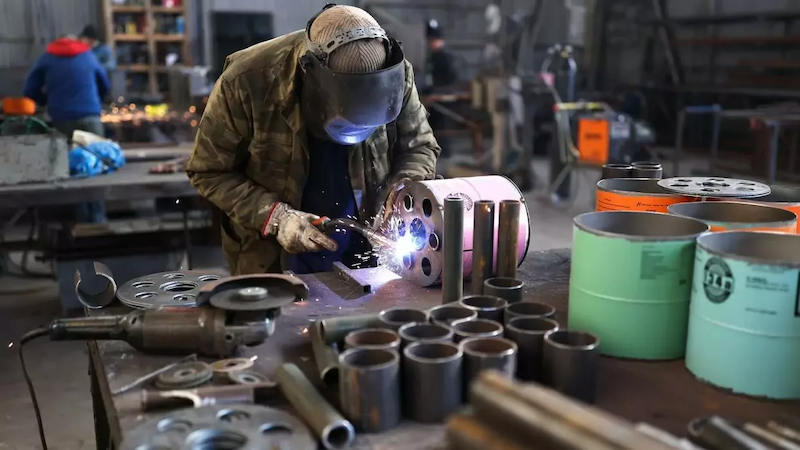
Russian Arms Production Q2 2023
By Pavel Luzin, Visiting Scholar of the Russia and Eurasia Program at The Fletcher School
According to recent leaks, Russian national defense spending surpassed 5.59 trillion rubles (more than $72.2 billion) for the first six months of 2023. The overall annual budget for the year was originally planned for 5.1 trillion rubles, or $74.7 billion according to the estimated exchange rate at the end of last year (Duma.gov.ru, November 10, 2022; The Moscow Times, August 4). This underlines Moscow’s increased commitment to the war against Ukraine, at least in nominal terms.
Meanwhile, the Russian Federal State Statistics Service, or Rosstat, recently published industrial data for the period running from January to June 2023, which allows for an update on the true state of arms manufacturing in the Russian Federation (see EDM, May 11; Rosstat.gov.ru, July 26, August 2). The manufacturing output indexes (in percentages) for those Russian industries related to arms manufacturing during the first six months of 2023 as compared to the same period of the past five years are as follows:

On the one hand, the new data displays a significant manufacturing increase in three of the four categories. As a result, the manufacturing output indexes in the first half of 2023 as compared to the first half of 2018 were:
- Chemical Materials and Chemical Products—117.3 percent;
- Computers and Electronic and Optical Devices—172 percent;
- Fabricated Metal Products, Except Machinery and Equipment (e.g., artillery rounds)—152.4 percent;
- Other Transportation Vehicles and Equipment (e.g., tanks, armored vehicles, civilian and military aircraft, locomotives and railway cars)—90.6 percent
On the other hand, if the material output of some specific products needed for the Russian military-industrial complex among other industries and exports supplied in January–June 2023 is compared to the same period for 2022, the situation looks a bit more sophisticated:
- Semi-Conductor Devices—101.6 percent (4.1 million units);
- Electronic Components—87.9 percent (33.1 million units);
- Artificial Fibers—71.4 percent (1,000 tons);
- Cellulose—96.5 percent (664,000 tons);
- Aluminum Powders—86.1 percent (amount classified);
- Aluminum Sections—131.4 percent (amount classified);
- Magnesium—109.5 percent (amount classified);
- Magnesium-Based Alloys—125.3 percent (amount classified);
- Titanium—126 percent (amount classified);
- Titanium Sections, Wires and Bars—91.4 percent (amount classified)
The production growth is much higher only if counted at the current ruble rate:
- Electronic Tubes—146.5 percent (4.5 billion rubles, $47.06 million);
- Radar and Navigation Equipment—124.4 percent (27.2 billion rubles, $284.44 million);
- Computers and Computer Parts—179.2 percent (9.8 billion rubles, $102.48 million)
These statistics demonstrate that a significant part of the formally growing manufacturing output indexes in Russia are due to increased costs as opposed to true growing material output. Nevertheless, Moscow has made efforts to increase the material output itself in these specific industries related to arms manufacturing. At the same time, it is unclear whether Russia has the capability to increase, or at least maintain, the current levels of production rates—let alone increase these numbers.
The growing costs for arms production are confirmed again by additional data from Russian state-owned corporation Rostec, the biggest arms manufacturer in Russia. Its consolidated revenue was 2.116 trillion rubles ($22.13 billion) in 2022 as compared to 2.064 trillion rubles ($21.58 billion) in 2021 and 1.878 trillion rubles ($19.64 billion) in 2020. Its earnings before interest, taxes, depreciation and amortization were 220 billion rubles ($2.3 billion) in 2022 as compared to 334.9 billion rubles ($3.5 billion) in 2021 and 283.2 billion rubles ($3 billion) in 2020. The corporation’s net profit in 2022 was 39 billion rubles ($407.84 million) as compared to 163 billion rubles ($1.7 billion) in 2021 and 111.2 billion rubles ($1.16 billion) in 2020. Additionally, the share of arms production is clear in the corporation’s reporting on revenue: 1.174 trillion rubles ($12.28 billion) in 2022 as compared to 1.125 trillion rubles ($11.76 billion) in 2021 and 1.241 trillion rubles ($12.98 billion) in 2020 (Rspp.ru, April 21, 2022; Rostec.ru, May 5; Rostec.ru, August 7). Briefly speaking, Rostec’s numbers reveal a sky-rocketing cost-plus inflation within the Russian military-industrial complex, which may come home to roost sooner rather than later.
Moreover, the drop in Russian arms production for 2022 was even deeper than the official statistics reveal. Overall, this means that the growth seen from January to June 2023 may be considered a form of recovery; however, there is still no “miracle” in Russian arms production as forces on the front struggle to withstand Ukraine’s ongoing counteroffensive.
(This post is republished from The Jamestown Foundation.)
